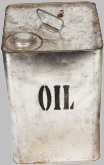Oil Viscosity
 Everybody recognizes 'oil' as a word for liquid materials that do not behave like water. They have a 'thickness' and self-cohesive character (autocohesion) that enables them to form a film on a surface. Oils have a characteristic feel when rubbed between one's thumb and forefinger. They are often compounds that have a high degree of hydrocarbon content in their molecules, especially those used as mechanical lubricants. The size of the hydrocarbon portions of the molecules, and the non-polar nature of the hydrocarbon structure, work together so that the molecules of an oil prefer to stick to each other and not interact with polar materials such as water. (Oil and water do not mix...) The combination of molecular size and autocohesive character produces a property in all fluids known as 'viscosity'. It can be defined either as a resistance to flow or as a resistance to the movement of something through that fluid.
Everybody recognizes 'oil' as a word for liquid materials that do not behave like water. They have a 'thickness' and self-cohesive character (autocohesion) that enables them to form a film on a surface. Oils have a characteristic feel when rubbed between one's thumb and forefinger. They are often compounds that have a high degree of hydrocarbon content in their molecules, especially those used as mechanical lubricants. The size of the hydrocarbon portions of the molecules, and the non-polar nature of the hydrocarbon structure, work together so that the molecules of an oil prefer to stick to each other and not interact with polar materials such as water. (Oil and water do not mix...) The combination of molecular size and autocohesive character produces a property in all fluids known as 'viscosity'. It can be defined either as a resistance to flow or as a resistance to the movement of something through that fluid.
Both of these definitions represent the resistance of the molecules of the fluid to separate from each other or 'sheer'. To illustrate the property of viscosity, use two identical containers, one of which is filled with water and the other with olive oil. Now drop identical marbles (or something similar) into each container and observe what happens. The marble will drop more slowly through the more viscous olive oil than through the water. Viscosity is temperature dependant. By heating the olive oil in the above example, it becomes more and more water-like in its consistency. As the viscosity of an oil 'breaks down' with increasing temperature, its ability to form a protective film also decreases and it may be squeezed entirely out from between the metal components that it must protect. Alternatively, viscosity increases as temperature decreases, and oils become more solid-like in character.
In internal combustion engines, lubricating oil viscosity must be maintained throughout the operating temperature range. Generally, viscosity is matched to a number of factors, but primarily to operating temperature and mechanical pressures. A lighter grade of oil may serve well at low temperatures but lose the ability to protect the engine adequately over prolonged periods at higher operating temperatures. A heavier grade of oil,on the other hand, may serve very well at higher temperatures, but become so thick as to cause damage to engine components when cold.
About the Author
Richard M J Renneboog, MS
 Richard M. J. Renneboog is an independent private technical consultant and writer in both chemical and computer applications. Endeavors have included preparation of scripts for instructional and promotional video, corporate website design, curriculum development for training in advanced composites technology, and development.
Richard M. J. Renneboog is an independent private technical consultant and writer in both chemical and computer applications. Endeavors have included preparation of scripts for instructional and promotional video, corporate website design, curriculum development for training in advanced composites technology, and development.


